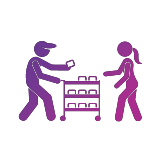Food Sensory Evaluation
Regulations
Nutraceuticals Regulations FSSAI
Interesting Topics
(Based on ASTM E1871 – Standard Practice for Sensory Evaluation of Foods and Beverages)
Table of Content
- 1. Sensory Evaluation and why it is important
- 2. Standard Serving Protocols for Sensory Testing
- 3. Food Samples be Prepared for Sensory testing
- 4. Right Serving Size for Sensory Test
- 5. Containers or Utensils should be used in sensory evaluation
- 6. Ideal serrving temperature for sensory Evaluation
- 7. Should palate cleansers used during sensory testing?
- 8. What are carriers and whenare they needed in sensory tests?
- 9. Should heated or cooked foods be handled for testing?
- 10. Microwave preparation standardized in sensory test?
- 11. Best practices for testing frozen products like ice cream
- 12. Sensory evaluation be done for dairy, meats, and baked goods
- 13. How do you control sample variability in sensory testing?
- 14. Environmental conditions should be maintained during sensory tests?
- 15. How many samples should be tested in one session?
1. What is sensory evaluation, and why is it important in food development?
Sensory evaluation is the science involved in measuring, analyzing, and interpreting the sensory characteristics of food and beverages: taste, smell, sight, touch, and hearing. Sensory evaluation is therefore important for product development, quality assurance, and consumer-testing functions to establish consistency, acceptability, and success in the market.
Example:
A food company is developing a new mango-flavored yogurt. Before launching the product, they conduct sensory evaluation with a trained panel to assess:
- Taste: Is the mango flavor natural and balanced with the yogurt base?
- Smell: Does the aroma match consumer expectations of fresh mango?
- Texture: Is it smooth and creamy or grainy?
- Appearance: Does the color suggest real mango and freshness?
- Overall Acceptability: Would consumers enjoy this product over current market options?
Through sensory evaluation, the company identifies that the aroma is too weak and the texture slightly chalky. They adjust the formulation accordingly—adding more mango puree and modifying the stabilizer—to improve consumer appeal before mass production.
2.What is the standard serving protocols for food sensory testing?
All aspects of the preparation and serving of food states the ASTM E1871 must be done properly, that is with respect to sample temperature, sample size, the type of container, and the presentation order. The environment must also be as odor neutral as possible, be neutral in lighting, and free from distractions to lessen bias.
[Reference: ASTM International. (2008). Standard Guide for Sensory Evaluation of Beverages (ASTM E1871 – 95(2008)) (See Section 5.1. General Guidelines).]
Example:
During a sensory test comparing three brands of tomato soup, the testing team assumes the following standard serving procedure:
- All soups are being served at 60°C for the sake of fairness in the evaluation.
- Cup sizes are identical for all testers (50 ml) in plain white cups.
- Working through a list of randomized numbers to eliminate any preconceived brand advantage is all the randomizing that is done for this test.
- The room has very quiet neutral lighting conditions and no strong odor of any kind.
- Then the testers need to evaluate the soups only—nothing about the setup.

3. How should food samples be prepared for sensory testing?
Sample preparation should decrease variability in product characteristics. Depending on the objective of the test, one could choose to pool samples together (to create uniformity) or keep samples separate (to notice any natural variation). It would be prudent to standardize serving temperature, serving time, and portion size for all assessors.
Example:
For instance, in the case of testing two vanilla yogurt brands:
- Several cups from each brand may be mixed to give all testers the same taste (this is pooled sampling).
- Or, if you want natural batch differences to count against them, let your sample be in their own cups (unpooled).
These are some conditions where any variation in temperature or how much is given to a person could influence their tastes, hence making the results unfair. Therefore, temperature, acting time, amount, and timing all need to be equalled out for everybody.
[Reference: ASTM International. (2008). Standard Guide for Sensory Evaluation of Beverages (ASTM E1871 – 95(2008)) (See Section 5.1.2.2).]
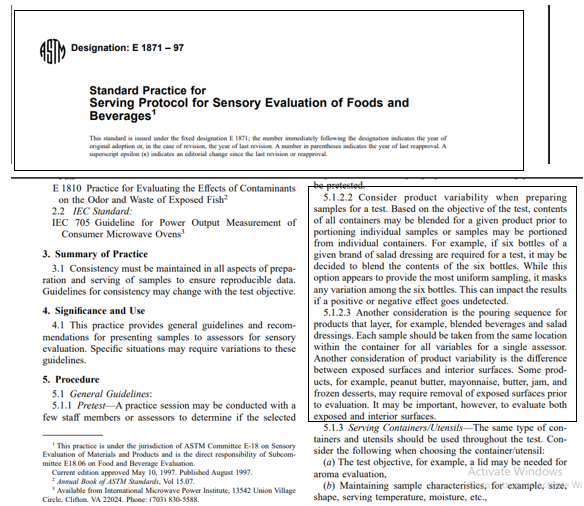
4. How do you determine the right serving size for sensory tests?
Serving size should be based on the product type and test objective. Enough quantity should be provided for multiple bites or sips to properly evaluate the full flavor or texture. Consistency is key—measuring tools like scoops or scales are often used.
[Reference: ASTM International. (2008). Standard Guide for Sensory Evaluation of Beverages (ASTM E1871 – 95(2008)) (See Section 5.1.4. Serving Size).]
Example:
In a cookie-tasting experiment, half a cookie is given to each person: enough to have 2 or 3 bites and decide on texture and taste. Juice testing requires 30-50 milliliters for 2 to 3 sips.
A measuring spoon or scale makes sure that every tester gets the same amount, so the test stays fair and reliable.

5. What containers or utensils should be used in sensory evaluation?
Use glass or certain plastics which are neutral, inert and odor-free. Don’t use colored containers or use scents besides when masking is required. All assessors should use identical utensils to avoid extraneous variable.
[Reference: ASTM International. (2008). Standard Guide for Sensory Evaluation of Beverages (ASTM E1871 – 95(2008)) (See Section 5.1.3. Serving container/utensils).]
Example:
In a typical tasting, clear plastic cups are used so the taster ought to see the color and the texture of the yogurt exam. All tasters were provided with white plastic spoons so that the mouthfeel or temperature of the spoon would not change.
Avoiding colored or scented containers ensures that the appearance and aroma cannot be distorted, keeping a consistent and unbiased result.
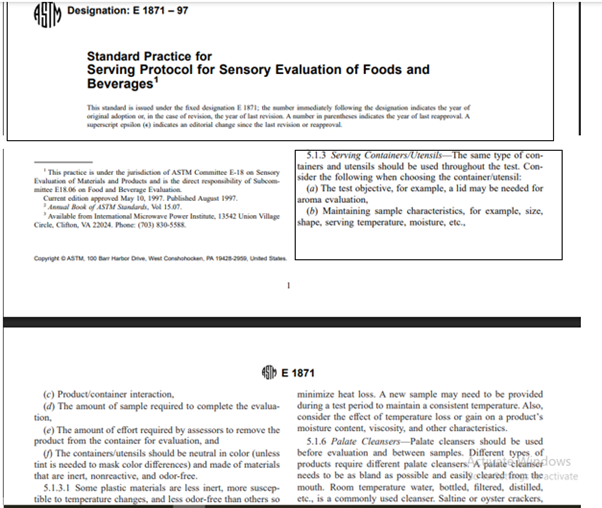
This varies by product:
- Hot food: Served mostly around 60-71 °C
- Cold Food: Below 4 °C
- Frozen dessert: – 18 – -10 °C
- Hot beverages: Around 58 – 60 °C
- All should be at consistent temperatures and pre-tested.
[Reference: ASTM International. (2008). Standard Guide for Sensory Evaluation of Beverages (ASTM E1871 – 95(2008)) (See Section 5.2.1&5.3.).]
Example:
If testing tomato soup, it should be served around 60–65 °C, so tasters experience the aroma and mouthfeel as they would with fresh serving. It could otherwise taste bland or greasy if served cooler.
With ice cream, any warmer than -10 °C would aid in fast melting, damaging texture, whereas colder than -20 °C could restrict flavor perception.
Hence, maintaining optimum temperature allows true and fair sensory evaluation.
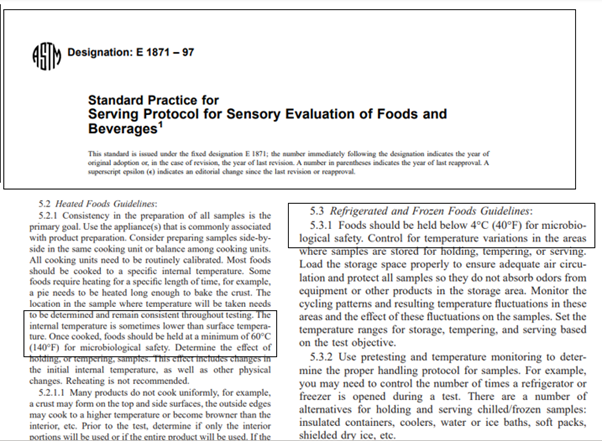
Yes. Palate cleansers such as water or unsalted crackers will be taken before and between samples to erase flavor transfer and be unbiased. The kind may vary from product to product.
Example:
If you’re tasting different types of cheese, a sip of room-temperature water or a bite of an unsalted cracker between samples can help clear leftover flavors.
Without this step, a strong-flavored cheese might affect how the next sample tastes, leading to biased results. Palate cleansers ensure each product is judged on its own.
[Reference: ASTM International. (2008). Standard Guide for Sensory Evaluation of Beverages (ASTM E1871 – 95(2008)) (See Section 5.1.6. Palate Cleaners).]
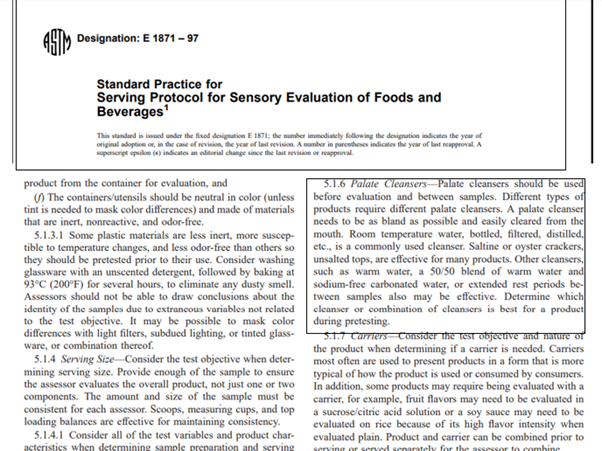
Carriers are pure foods, such as bread, rice, or lettuce, used as carriers to bring about more realistic consumption or to lessen flavor intensity. They are added to very strong-flavored items, such as sauces and condiments, to create a uniform taste-testing environment.
Example:
If tasting soy sauce, the assessors may use plain white rice, instead of tasting it directly. This method mirrors the usual way one consumes soy sauce, with the saltiness otherwise dominating the senses. Likewise, salad dressing may be tested on lettuce leaves, and chocolate syrup may be tested on vanilla ice cream-these carriers simulate the real-use situations and provide a fair comparison of the samples.
[Reference: ASTM International. (2008). Standard Guide for Sensory Evaluation of Beverages (ASTM E1871 – 95(2008)) (See Section 5.1.7. Carriers).]
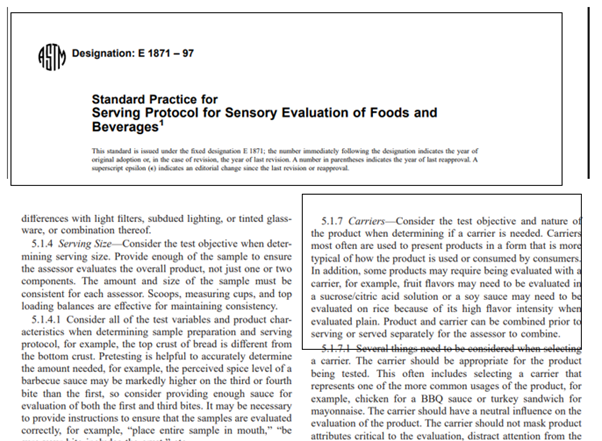
9.How should heated or cooked foods be handled for testing?
Heated food should be prepared equally with standardized appliances and carefully observed with respect to temperature. Holding method such as heated trays or steam tables is utilized so that customers are served at the right temperature without compromising the quality of the product.
Example:
If you’re testing three brands of frozen lasagna, each one should be cooked in the same type of oven, for the same time, and to the same internal temperature.
After cooking, they should be kept warm on heated trays at ~60°C until served—this avoids one brand being tested hot and another lukewarm, which could affect how the texture or flavor is perceived.
[Reference: ASTM International. (2008). Standard Guide for Sensory Evaluation of Beverages (ASTM E1871 – 95(2008)) (See Section 5.2. Heated food guidelines).]

10.How is microwave preparation standardized in sensory tests?
Apply the same brand and wattage for microwave ovens. Routine calibration of the ovens is essential, as are identical heating times and beyond, rotation or stirring of samples to avoid hot/cold spots, in addition to avoiding extension cords and using one oven per circuit.
[Reference: ASTM International. (2008). Standard Guide for Sensory Evaluation of Beverages (ASTM E1871 – 95(2008)) (See Section 5.2.2. Microwaved).]
Example
The sensory test involves two brands of frozen lasagna samples, all of which are heated using Samsung 1000 watts. The microwave heats up for 4 minutes, and the samples are stirred halfway through to ensure even heating, after which they are kept standing for a minute before serving. Each oven is registered with a dedicated circuit without any extension cords to avoid any power fluctuations. Hence, all samples are given equal preparation in minimizing any variations that can affect sensory perception.
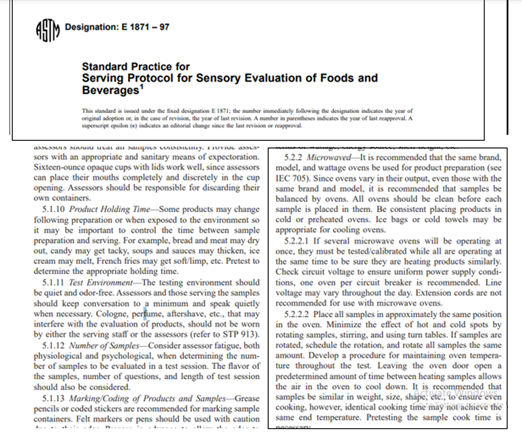
11. What are best practices for testing frozen products like ice cream?
Before serving, frozen items must be tempered to a uniform temperature. Serve immediately after removing from the freezer and try to avoid scraping the sides to keep product integrity. All samples should come from the same carton location.
[Reference: ASTM International. (2008). Standard Guide for Sensory Evaluation of Beverages (ASTM E1871 – 95(2008)) (See Section 5.4.9. Frozen dessert products).]
Example
For testing vanilla ice cream, samples must be taken from the container’s center. The upper or side section is not suitable since there would be variations in texture and temperature. The ice cream should be slightly tempered to around -14 °C so that it can be scooped with ease and tasted. If one serves the sample rock-hard and the other goal slightly melted, assessors might judge creaminess or sweetness; this’ll distort the results.
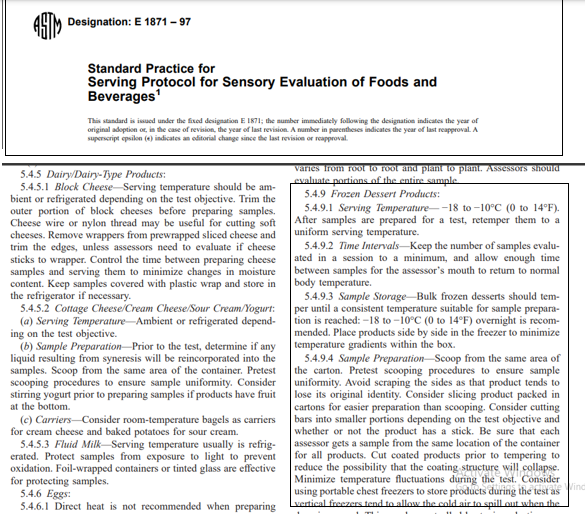
12. Can sensory evaluation be done for dairy, meats, and baked goods?
It is totally possible. Each category has its specific ways to handle:
- Dairy: Trim surfaces and control moisture loss
- Meats/Fish: Ensure proper cooking temps (e.g., poultry to 74°C)
- Bakery: Control the Crust and edge-browning with moisture.
[Reference: ASTM International. (2008). Standard Guide for Sensory Evaluation of Beverages (ASTM E1871 – 95(2008)) (See Section 5.2.2. Microwaved).]
Example
In a sensory test for cheddar cheese, the slices are cut from the center of the block to avoid dry or oxidized edges, so height, moisture, and flavor are uniform.
For grilled chicken, each sample is cooked to a temperature of 74°C with a food thermometer. Pieces that are overcooked or undercooked are discarded to standardize for texture and juiciness.
In bread rolls testing, the baking time and temperature are kept uniform to achieve similar crust color and softness to avoid any differences in browning that may influence the taste or texture rating.
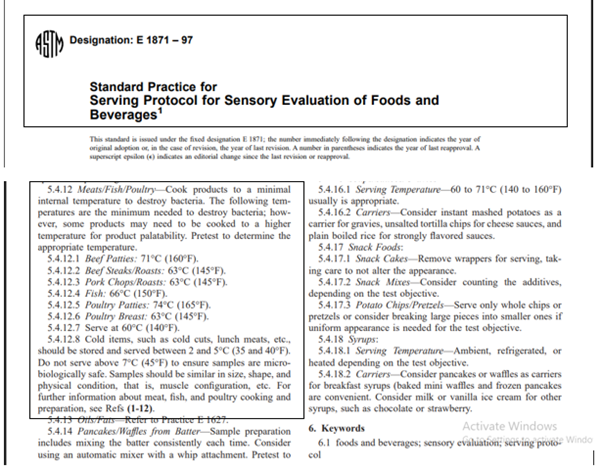
13. How do you control sample variability in sensory testing?
Use pretesting to evaluate sample consistency. Consider blending, portioning from the same area of a container, or removing exposed surfaces. Record and replicate preparation steps exactly.
Example
The yogurt sensory test samples are drawn from the middle portion of the container to avoid surface drying and whey separation. Soups are of one lot and blended prior to portioning to ensure uniformity in thickness and spice level in each cup. The preparation steps, including heating times and stirring procedures, are all written down and strictly adhered to during every test session to minimize variability.
[Reference: ASTM International. (2008). Standard Guide for Sensory Evaluation of Beverages (ASTM E1871 – 95(2008)) (See Section 5.1.2. Product Variablity).]
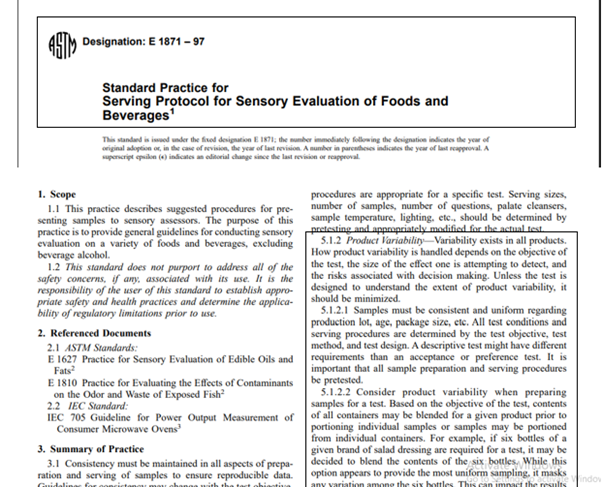
14. What environmental conditions should be maintained during sensory tests?
Ideally, it would be quiet, odorless, neutral-colored rooms, far from loud conversations, perfumes, and unneeded movement. These are based on sensory interference.
[Reference: ASTM International. (2008). Standard Guide for Sensory Evaluation of Beverages (ASTM E1871 – 95(2008)) (See Section 5.1. General consideration).]
Example
Sensory testing booths are usually white. They have no windows, and the subdued neutral lighting is purposely set to eliminate visual distractions. The place is considered an odor-free zone, disallowing the use of perfumes and cooking activities in the vicinity. White noise can be generated to mask environmental noise, ensuring that tasters only focus on the food themselves and different environmental influences.
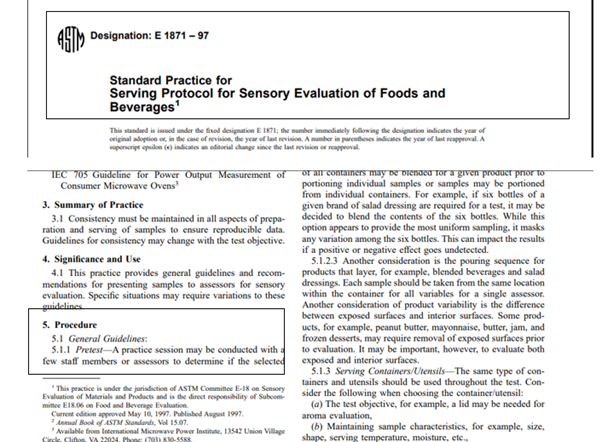
15. How many samples should be tested in one session?
Again, depending on the type of product, the complexity of the test, and avoidance of overloading assessors to prevent fatigue, generally from 4 to 8 samples would be a more realistic range for most food types.
[Reference: ASTM International. (2008). Standard Guide for Sensory Evaluation of Beverages (ASTM E1871 – 95(2008)) (See Section 5. Genera consideration).]
Example
If you’re testing different flavors of potato chips, offering 6 samples in one session is reasonable. This allows assessors to compare textures and flavors without getting tired or losing sensitivity. But for more intense items like spicy sauces, only 4 samples may be ideal to avoid palate fatigue or sensory overload.


Let’s create something Innovative and Delicious together
Food Research Lab strives for excellence in new Food, Beverage and Nutraceutical Product Research and Development by offering cutting edge scientific analysis and expertise.


